Königstein, Saxony
Königstein (Upper Sorbian: Kralowc) is a town in the Free State of Saxony in Germany. Königstein lies in the Sächsische Schweiz-Osterzgebirge District and had a population of 2,089 in 2018. The Königstein Fortress is situated above the town.
Königstein | |
|---|---|
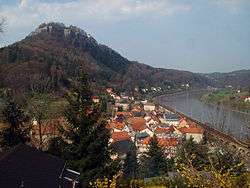 | |
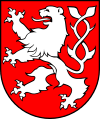 Coat of arms | |
Location of Königstein within Sächsische Schweiz-Osterzgebirge district   | |
 Königstein 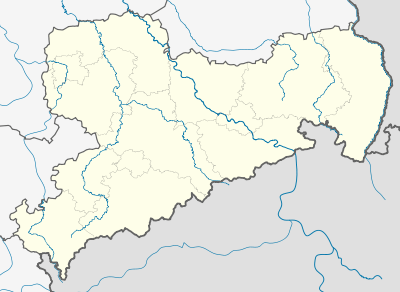 Königstein | |
| Coordinates: 50°55′8″N 14°4′17″E | |
| Country | Germany |
| State | Saxony |
| District | Sächsische Schweiz-Osterzgebirge |
| Municipal assoc. | Königstein/Sächs. Schweiz |
| Subdivisions | 2 |
| Government | |
| • Mayor | Tobias Kummer[1] |
| Area | |
| • Total | 26.93 km2 (10.40 sq mi) |
| Elevation | 212 m (696 ft) |
| Population (2018-12-31)[2] | |
| • Total | 2,089 |
| • Density | 78/km2 (200/sq mi) |
| Time zone | CET/CEST (UTC+1/+2) |
| Postal codes | 01824 |
| Dialling codes | 035021 |
| Vehicle registration | PIR |
| Website | www.koenigstein-sachsen.de |
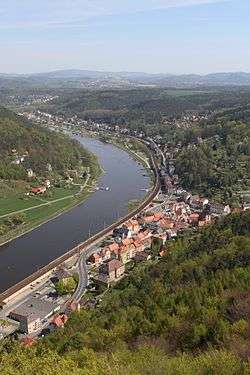
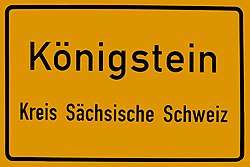
Geography
Königstein is located in the Elbe Sandstone Mountains. The town lies in between Pirna and the Czech border at the confluence of the Biela with the Elbe. Königstein was damaged during the flooding of the Elbe in 2002.
History
The town of Königstein was first mentioned in 1379 as a settlement near the castle of Königstein. It was named after a King of Bohemia, but eventually passed to the Saxon Margraves of Meißen. However, Königstein still retains the double-tailed lion of Bohemia in its coat of arms. During World War II the prisoner-of-war camp for Allied officers, Oflag IV-B, was located in the castle.
References
- https://www.koenigstein-sachsen.de/de/Koenigstein/Begruessungswort-Buergermeister
- "Bevölkerung des Freistaates Sachsen jeweils am Monatsende ausgewählter Berichtsmonate nach Gemeinden" (PDF). Statistisches Landesamt des Freistaates Sachsen (in German). July 2019.
External links
- Municipal website (in German)